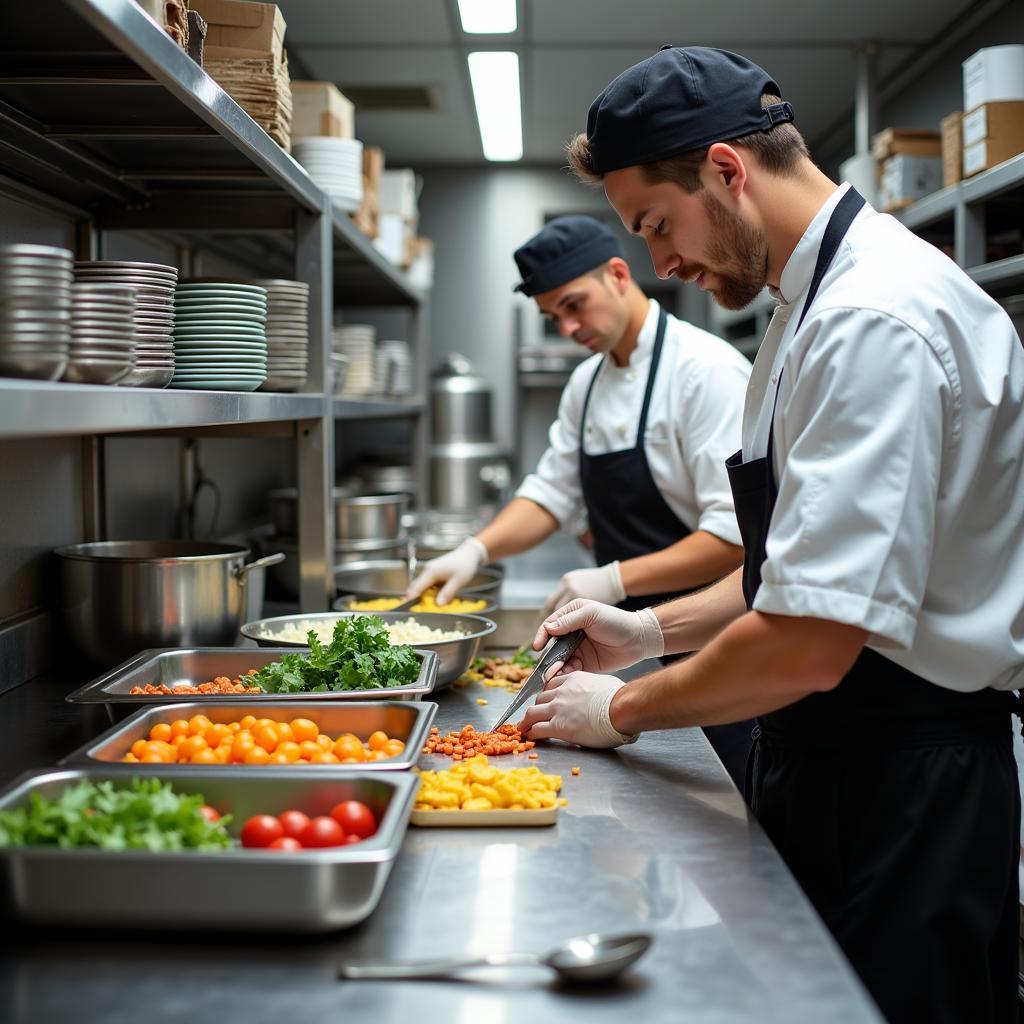Proper food storage is the backbone of any successful commercial kitchen. It’s not just about preventing spoilage; it’s about ensuring food safety, maintaining quality, and optimizing your operations. That’s where choosing the right Commercial Kitchen Food Storage Containers comes in.
Why Investing in Quality Food Storage Matters
Imagine this: you’ve prepped a beautiful batch of fresh berries for your signature dessert, only to find them wilted and discolored the next day. Subpar storage containers can lead to food waste, impacting your bottom line and frustrating your team.
Here’s why choosing the best commercial kitchen food storage containers is crucial:
- Food Safety: Proper containers prevent cross-contamination and create a barrier against bacteria and other contaminants.
- Quality Control: Maintain the freshness, texture, and flavor of your ingredients for longer, leading to consistent dish quality.
- Efficiency: Durable, stackable containers optimize space and streamline your workflow.
- Cost Savings: Minimize food waste, reduce the risk of health code violations, and save on frequent replacements.
Navigating the World of Commercial Kitchen Food Storage Containers
From deli quarts to ingredient bins, the options can be overwhelming. Here’s a breakdown to guide your decision:
1. Material Matters: Choosing the Right One for the Job
- Polycarbonate: Virtually indestructible, temperature resistant, and dishwasher safe. Ideal for heavy-duty use and hot foods.
- Polypropylene: Lightweight, affordable, and generally freezer safe. A versatile option for a range of storage needs.
- Polyethylene: Flexible, impact-resistant, and often microwave safe. Suitable for short-term storage and freezing.
- Stainless Steel: Durable, non-reactive, and easy to sanitize. Perfect for large-scale storage, mixing bowls, and steam tables.
 Stainless Steel Food Storage Containers in Commercial Kitchen
Stainless Steel Food Storage Containers in Commercial Kitchen
2. Sizing Up Your Needs: From Small Bites to Bulk Storage
Consider your menu and workflow. Do you need small containers for prepped ingredients or large bins for bulk ingredients?
- Ingredient Prep: Deli containers, prep bowls, and small storage boxes are your go-to for mise en place.
- Bulk Storage: Look for ingredient bins, stackable containers, and large tubs with lids for storing flour, sugar, and other staples.
- Leftovers and Transport: Invest in airtight containers, insulated carriers, and Cambro containers for safe storage and transport.
3. Labeling is Key: Keeping it Organized
Food safe pens are essential for a well-organized kitchen. Clearly label your containers with:
- Contents and Date: This ensures proper rotation and minimizes waste.
- Allergen Information: Crucial for preventing cross-contamination and ensuring safety.
- Color-Coding System: Assign colors to different prep days or ingredient types for easy identification.
Pro Tips for Maximizing Your Food Storage System
- First In, First Out (FIFO): Always use the oldest ingredients first to minimize waste.
- Temperature Control: Store food at the appropriate temperature (refrigerated, frozen, or room temperature) to maintain freshness.
- Regular Cleaning: Thoroughly wash and sanitize containers between uses to prevent cross-contamination.
- Airtight is Right: Choose airtight containers to prevent freezer burn, maintain freshness, and keep pests at bay.
“Investing in quality food storage containers is investing in the success of your business,” says Chef [Expert Name], a seasoned culinary professional with over 20 years of experience. “Not only does it elevate your food safety practices, but it also streamlines your operations, saving you time and money in the long run.”
Choosing the Right Containers for the Job: A Quick Guide
| Food Type | Container Material | Size and Shape | Additional Considerations |
|---|---|---|---|
| Prepped Vegetables | Polycarbonate, Polypropylene | Deli quarts, prep bowls | Airtight lids, clear for visibility |
| Raw Meat | Polypropylene, Stainless Steel | Deep containers with lids | Leakproof, separate from other foods |
| Dry Ingredients | Polycarbonate, Stainless Steel | Ingredient bins, airtight containers | Clearly labeled, pest-proof |
| Sauces and Soups | Polycarbonate, Stainless Steel | Cambro containers, storage boxes | Temperature resistant, leakproof |
FAQs about Commercial Kitchen Food Storage Containers
What are the best containers for storing liquids?
Look for leakproof containers with tight-fitting lids, such as Cambro containers or those made from polycarbonate or stainless steel.
Can I use glass containers in a commercial kitchen?
While glass is generally safe for food storage, it’s often prohibited in commercial kitchens due to the risk of breakage.
How often should I replace my food storage containers?
Inspect containers regularly for cracks, warping, or discoloration. Replace them immediately if you notice any damage.
What are some innovative storage solutions for small kitchens?
Consider wall-mounted shelving, stackable containers, and utilizing vertical space to maximize storage capacity.
Need More Information?
Explore our other helpful resources:
- Food Safe Sanitizing Wipes: Learn about maintaining a hygienic food prep environment.
- 1/6 Size Food Pan Dimensions: Find the right size food pans for your needs.
- Commercial Food Storage Containers: Browse our selection of high-quality food storage solutions.
Ready to Upgrade Your Kitchen?
Choosing the right commercial kitchen food storage containers is an investment that pays off. By prioritizing food safety, efficiency, and durability, you’re setting your kitchen up for success. Contact us today at [Phone Number], email us at [Email Address], or visit us at [Address]. We’re here to help you find the perfect storage solutions for your commercial kitchen.